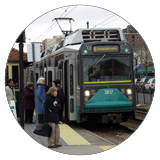 The Boston Region MPO (MPO) recently created a Park-and-Ride dashboard to showcase parking use and capacity data at all MBTA stations. Many MBTA stations, which include regional rail and rapid transit, have park-and-ride lots that people traveling to work use every day. Park-and-ride lots can be critical in helping people who do not live within walking distance of a station to access public transit. Since 2000, the MPO has periodically collected parking data, both of personal vehicle and bike, at every parking lot near MBTA stations. This includes those owned by the MBTA, owned privately, and owned by the municipality the station is located in. The data not only helps inform the public about parking information at MBTA stations, but also provides planners and engineers insight on where to invest in transportation infrastructure to support people taking transit.
The Boston Region MPO (MPO) recently created a Park-and-Ride dashboard to showcase parking use and capacity data at all MBTA stations. Many MBTA stations, which include regional rail and rapid transit, have park-and-ride lots that people traveling to work use every day. Park-and-ride lots can be critical in helping people who do not live within walking distance of a station to access public transit. Since 2000, the MPO has periodically collected parking data, both of personal vehicle and bike, at every parking lot near MBTA stations. This includes those owned by the MBTA, owned privately, and owned by the municipality the station is located in. The data not only helps inform the public about parking information at MBTA stations, but also provides planners and engineers insight on where to invest in transportation infrastructure to support people taking transit.
Blog - Articles tagged as MBTA

On June 7, following a four-week pilot, the City of Boston announced the permanent installation of a bus lane on Washington Street between Roslindale Square and the Forest Hills MBTA station. This corridor was identified as a candidate for a bus lane through MPO staff work, which examined corridors in the Boston region where buses are routinely delayed in traffic.

Conversations about improving transit access for underserved communities often revolve around creating new service or implementing more frequent service on existing lines. However, recent work funded by the Boston Region Metropolitan Planning Organization (MPO) approaches the issue from a different angle...

At the October 6 meeting of the Boston Region MPO, board members voted to initiate a study to research ways to reduce wait times for bus passengers on corridors in which multiple bus routes operate, so-called “trunk sections” of the MBTA bus network.

The plan to extend Green Line light rail service to Somerville and Medford is getting back on track after the project stalled last year because of significant cost overruns, a setback that inflated the cost estimate from nearly $2 billion to as much as $3 billion and caused the state to put construction on hold and re-evaluate the project design, procurement, management, and funding.

On August 18, 2016, the MPO amended its Long-Range Transportation Plan (LRTP), Charting Progress to 2040, to make the document consistent with the MPO’s recently adopted Transportation Improvement Program (TIP)—a rolling five-year plan that finances construction of highway, transit, and multimodal projects and programs—and the Massachusetts Department of Transportation’s Capital Investment Plan (CIP)—which documents projects that are prioritized and funded by the state.
Article Search
Archive
Tags
